NREL's Annual Partner Forum Eyes Pathways to Future Energy Systems
Power Grid Experts and Industry Leaders Share Thoughts on Achieving Top-to-Bottom Energy Transformation
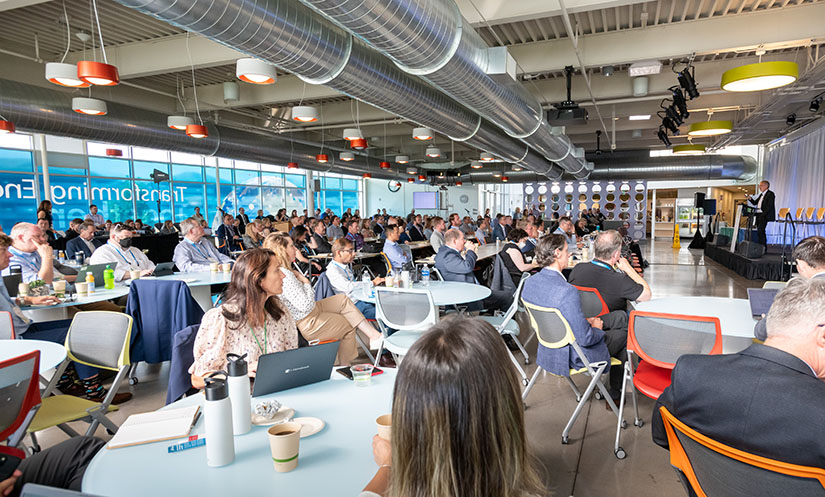
The 7th NREL Partner Forum brought energy experts to NREL’s campus in Golden, Colorado, to discuss the challenges of future energy systems. Photo by Bryan Bechtold, NREL
Everything is in place for a complete energy transformation: Cheap power is gathered on rooftops, fuel can be made from electricity, entirely new grid architectures are possible—but such big changes do not come easily.
On the brink of extraordinary energy investments, partners from utilities, companies, and cities gathered at the U.S. Department of Energy National Renewable Energy Laboratory's (NREL’s) 7th Partner Forum, Aug. 21–23, to discuss how to navigate the complex challenges of future energy systems through technological integration and detailed planning.
All attendees have unique experiences on the topic, but the conversation started with an exceptional perspective from Nancy Sutley, the Los Angeles deputy mayor for energy and sustainability, who worked with NREL to facilitate the groundbreaking LA 100 study for planning Los Angeles’ clean energy investments.
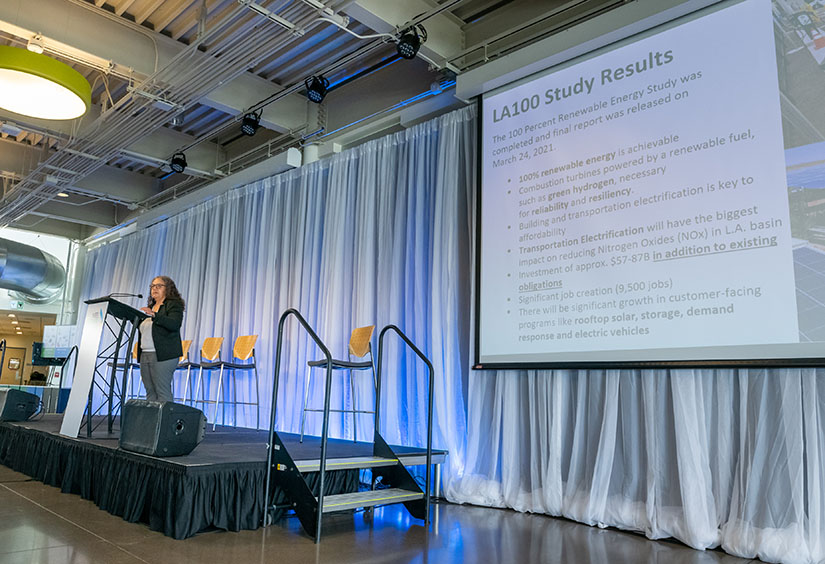
“In Los Angeles, we understand how important the energy transition is to addressing climate change. We’ve had some of the driest winters followed by one of the wettest winters on record. And a hurricane just came through—I didn’t have that on my weird weather card!” Sutley remarked. “But we have to make sure the transition is just. The effects fall disproportionately on the poor, with people worried about running AC during extreme heat. We need to highlight the importance of affordability, energy debt, and empowering residents to participate at every step.”
Sutley’s keynote struck at the center of why energy transitions are so hard: multibillion dollar investments into the unknown, bound by the need for resilience, reliability, and affordability and complicated by the uncertainties of policy, permitting, and technology.
“For cities the size of Los Angeles, we’re talking about $90 billion spent on updating energy systems,” emphasized Bill Farris, associate laboratory director for Innovation, Partnering, and Outreach at NREL. "You can’t spend that twice."
Biggest Challenges: Growing Demand, Tech Deployment, and Unpredictability
In his comments, NREL Laboratory Director Martin Keller pointed to the uncertainties in energy planning: A country like Ukraine needs extreme energy resilience that is resistant to the volatility of warfare, while other communities need resilience to confront the variability of weather.
“We don’t even know if ocean currents might change,” Keller said.
Other panelists expressed frustration with the fogginess around project permitting and siting. When asked what he would do with a $50 million blank check, Xcel Energy Vice President of Integrated Planning Steve Martz said he would “purchase policy insurance to help create certainty in the market.”
“Interconnection studies start in the tens of thousands of dollars, then we wait years for results. The timing is too long, and it introduces risks and cost to the project development,” Martz said.
On top of policy changes, the energy supply itself is becoming more uncertain. Martz noted, just as dense clouds floated over the foothills and shaded NREL’s campus, “We can see large renewable ramp-downs occur within minutes.”
All the uncertainty is complicated by another major trend: NREL analysis finds that future electrification could substantially increase electricity demand. Utilities will soon have to supply more electricity while also worrying about lagging approvals and resource reliability. But technology solutions are on the table, even if they need a push to get up to scale.
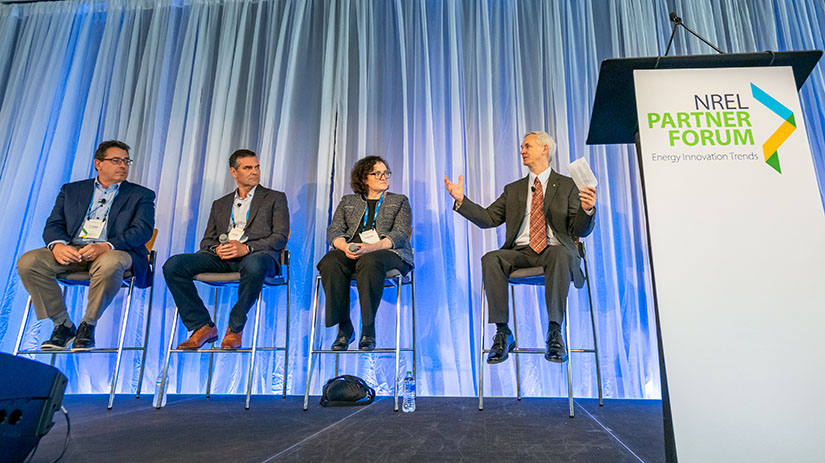
“Deployment problems are related to friction in the system,” said Scott Harden, chief technology officer of Schneider Electric. “The good news is that technology solutions are becoming ubiquitous, and soon, like the internet, they will seamlessly work. We are now seeing more partnerships with utilities that are broader than a single technology. These 'lighthouse alliances' look out at big challenges and create scenarios to work together to deliver substantial outcomes. It’s really important from our perspective to have NREL act as a broker to drive atypical partnerships and get everyone to collaborate.”
Another roadblock to future energy systems, attendees agreed, is the scaling of technologies. No doubt, NREL and partners are breaking new technological ground, but those innovations face a gigawatt-sized gap to reach full deployment.
“Utility technology is underinvested,” said CEO and Co-Founder of Camus Energy Astrid Atkinson. “We need rapid innovation, through deployment and iteration, but industry doesn’t have a lot of muscle for doing that, and utilities only go through tech adoption when they have a pressing need. There is lots of great R&D happening in the national labs, but it’s difficult to connect it to the field.”
The issue of validating tech for field deployment is one of the main value propositions for NREL’s Advanced Research on Integrated Energy Systems (ARIES), which was a featured topic throughout the forum.
Panelists also implored others to think creatively about fulfilling new demand. Whether placing electric vehicle (EV) charging stations at streetlight poles or using phasor measurement units to enhance software optimization, some solutions might just require the right technological integration at scale. Unlike in the past, many of those technological solutions now depend on customer engagement.
Connecting to the Customer
At the edge of the electric grid, where power distribution terminates at customer loads, a revolution is happening. Not just because rooftop solar and electric vehicles introduce two-way power flow, but also because of an evolving hardware ecosystem that allows customers to collectively influence the grid. This emerging force at the far end of power distribution has industry and utilities asking, “What’s the new role of the customer, and how can we work together?”
Discussion repeatedly returned to bringing customers into the fold by educating and encouraging them to participate and by connecting to their energy devices. A panelist described residential electrical panels as a load center, where behind-the-meter assets like electric vehicles, batteries, and appliances can be managed for grid optimization. These devices can be aggregated to provide load or supply flexibility. The crux of the problem for partners is designing new controls for devices and the incentives for customers.
“It’s a tremendous undertaking to get customers to adopt new technologies, especially because many of these technologies are at low levels of readiness,” Martz said. “Think about smart thermostats … utilities are practically giving these away. Our solution is to provide as many options as possible and let customers choose, while looking at the rate impacts of all options.”
Panelists agreed that messaging is a major challenge in reaching customers. Utility jargon and tariff documents are impossible for nonexperts to understand, and energy programs and customer input can get lost in translation.
Customers are not the only ones struggling with the shift. The workforce also lacks familiarity with the new concepts and technologies defining the energy transition. One utility panelist commented that workforce unfamiliarity is currently the number one barrier; engineers are still thinking in transformers and wires, instead of cloud computing and artificial intelligence. Suggested solutions included more training in information technology and the “uberization” of labor.
How Can the National Laboratories Help?
With so many partners in attendance, the role of national laboratories was no mystery: They continue to be places of convergence, unbiased testing, and consensus-building research. Sutley summed up NREL’s importance in the LA100 study during the keynote.
“The technical independence and credibility of NREL was very helpful for the community to know what is possible,” Sutley said. “I mean, y’all have a supercomputer to literally run thousands of scenarios and model LA’s energy system at the building levels.”
NREL research capabilities are always evolving—now more than ever. This was unmistakable, with a large banner aside the main stage showing a rendering of the soon-to-be Glo Park, a Colorado-owned site adjacent to NREL’s campus that will host global energy collaboration. Visitors were also treated to a tour of NREL’s two premier facilities for power system research: the Energy Systems Integration Facility (ESIF) and the Flatirons Campus. Connections between the two comprise the ARIES capability and represent the highest-power, widest-scope capability available for energy systems research at NREL. On the last day, visitors attended a birthday party to celebrate 10 years of the ESIF, with speeches, cake, and self-guided tours.
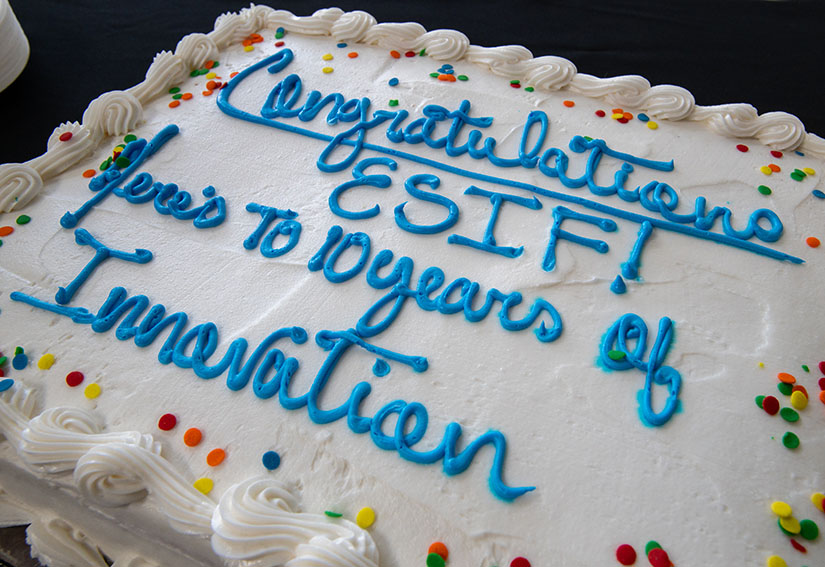
The closing panel sessions zeroed-in on the impact that ARIES makes for laboratory partners. Dallas Fort Worth (DFW) International Airport Vice President of Environmental Affairs and Sustainability Robert Horton spoke with NREL leadership about the airport’s experience in planning its energy transition using ARIES assets.
“Airports are incredibly siloed; we need a platform that integrates heterogenous data, to understand stakeholder perspectives and solve challenges collaboratively,” Horton said. “It’s impressive what we can do with ARIES—to visualize the scale and complexity of problems and bring together different sectors into one testing space. We can look into the future with ARIES.”
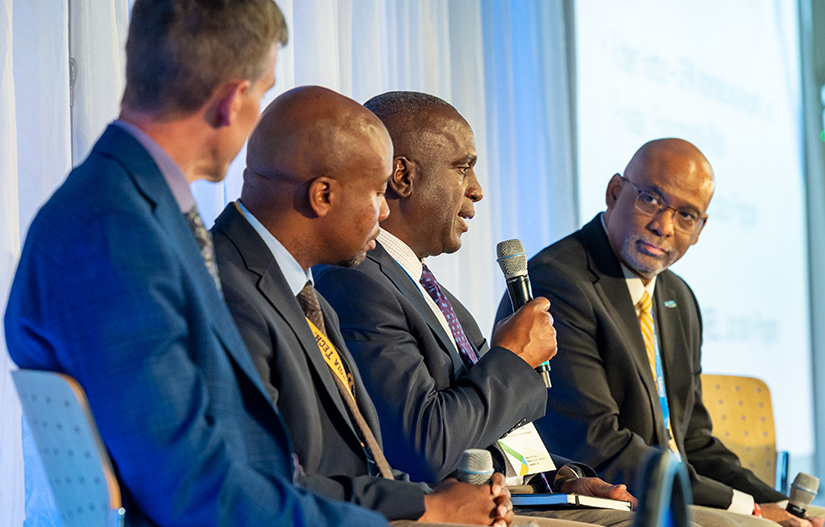
John Farrell, laboratory program manager at NREL, commented that DFW’s transition is a microcosm for energy integration, specifically for buildings and transportation. In this sense, it can be an example for strategically managing vehicle charging and diverse loads.
“Industries can learn from us and vice versa,” Horton agreed. “We want to deliver transferable findings to the complex challenges of other organizations.”
Get Involved
As NREL plans for growth, expands its campus, and boosts its research capabilities to take on the global challenges of energy transformation, now is a great opportunity to partner with the national laboratories. An upcoming ARIES user call is available for proposals. Projects will use the ESIF’S Advanced Distribution Management System Test Bed to validate vehicle-to-grid integration strategies.
Learn more about partnering with NREL.
Last Updated May 28, 2025
